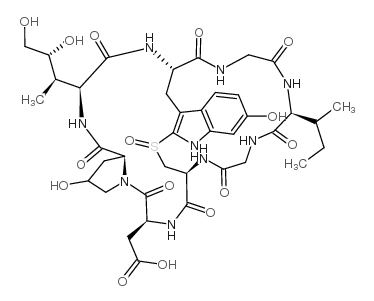21150-22-1
| Name | β-AMANITIN |
|---|---|
| Synonyms |
MFCD00151212
8,20,23,24,27,30,33-octaoxo--dihydroxy-1-methylpropyl)-11-oxide EINECS 244-244-8 B-amanitin from amanita phalloides B-Amanitine ,12,17,18,19,20,21,22,23,23a-octadecahydro-29-sec-butyl-2,14-dihydroxy-21-(2,3 |
| Description | β-Amanitin is a cyclic peptide toxin in the poisonous Amanita phalloides mushroom. β-Amanitin inhibits inhibits eukaryotic RNA polymerase II and III. β-Amanitin inhibits protein synthesis. β-Amanitin can be used as a cytotoxic component of antibody-drug conjugates (ADCs)[1][2]. |
|---|---|
| Related Catalog | |
| Target |
Traditional Cytotoxic Agents |
| In Vitro | β-Amanitin (0.01-100 µg/mL; 36 hours) shows toxicity in MCF-7 cells, and the rates of cell viability are calculated as 52%, 62%, 84%, 86%, and 91% at concentrations of 100, 10, 1, 0.1, and 0.01 µg/mL, respectively[2]. β-Amanitin shows a great inhibition of protein synthesis at both concentrations (10 µg/mL and 1 µg/mL) in MCF-7 cells for 24 hours[2]. Cell Viability Assay[2] Cell Line: MCF-7 cells Concentration: 0.01, 0.1, 1, 10, 100 µg/mL Incubation Time: 36 hours Result: Showed toxicity in MCF-7 cells. |
| References |
[2]. Lutz C, et al. Alpha- and Beta-Amanitin Total Synthesis. Angew Chem Int Ed Engl. 2020 Feb 24. |
| Molecular Formula | C39H53N9O15S |
|---|---|
| Molecular Weight | 919.95400 |
| Exact Mass | 919.33800 |
| PSA | 394.30000 |
| Index of Refraction | 1.695 |
CHEMICAL IDENTIFICATION
HEALTH HAZARD DATAACUTE TOXICITY DATA
|
| Symbol |

GHS06 |
|---|---|
| Signal Word | Danger |
| Hazard Statements | H300-H310-H330 |
| Precautionary Statements | P260-P264-P280-P284-P302 + P350-P310 |
| Hazard Codes | T+ |
| Risk Phrases | R26/27/28 |
| Safety Phrases | S7;S28;S45;S36/S37/S39 |
| RIDADR | UN 3462 6.1/PG 1 |
| RTECS | NJ8324000 |
| Hazard Class | 6.1(a) |
